1
Section One: The Fundamentals
A) What do we know about sport? What are common assumptions we make about sport and society?
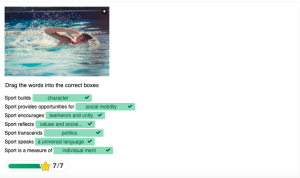
| The idea that sports transcend politics is flawed and certainly untrue in many ways. Firstly, within sports, gender-based inequalities are very prevalent, with a higher focus and appreciation on male-oriented sports. For example, the NBA is a male-dominated industry, with hundreds of millions of dollars used to fund these games and the league as a whole. In contrast, the WNBA (Women’s National Basketball) league receives significantly less attention and funding than its counterpart. This shows how sports do not transcend politics as sexism and misogyny in sports are a direct response to the political and systematic state of society. Another example of sports not transcending politics is the male presence in the NHL. Recently, Jessica Campbell became the first female NHL coach and she, as well as the team she coached, faced quite a bit of backlash due to this decision. This visceral reaction from social media and other media forms serves as an example of the political state responsible for gender oppression, that seeps into even sports. Therefore, in this sense, sports do not transcend politics.
Something noted by another student that intrigued me was how they brought up the accessibility issues regarding sports. Due to the high costs of participation in sports, marginalized communities are unable to share their voices, which prohibits sports from ‘speaking a universal language.’ I had never considered how the high costs and even physical inabilities could keep a group from entering the athletic realm as a whole, so we don’t see the ‘full story’ as a lot of people don’t even get a chance to participate. |
Exercise 3: Notebook prompt
What are some other metanarratives about sport that you are familiar with? Find an image or video clip or draw something yourself that captures this idea…
So what? Why does any of this matter? Does it matter? As something we grow up with – live with – play through – we don’t often interrogate the meanings of sport, and perhaps we don’t want to.
But being aware of these assumptions and metanarratives is especially important, I would argue, because of the centrality of sport to our everyday lives, the role that sport plays in shaping our childhood and worldviews and….. [finish that thought]

| An example of a metanarrative that comes to mind when thinking of sports and its impact on our worldviews is the idea of the ‘underdog’. I think this idea is very important to people as a lot of people can relate to the ‘underdog.’ This is because we have all struggled in one way or another, which makes a lot of people feel as though they need to prove themselves to others and overcome any barrier or struggle that stands in the way. This is applied on a sociological level as we can feel we are the ‘underdog’ in school, friendships, relationships, jobs, careers, and certainly in sports. This idea touches every part of our lives in one way or another. Furthermore, when people see an ‘underdog’ overtake adversity in front of millions of people in the form of a sport shows people hope for themselves. It is inspiring and can be used to ignite a desire to become the best you can be because we can see it happening in a game right before our eyes. The use of an ‘underdog’ is popular in sports as it serves as a personification of how we view ourselves in our lives, and the ‘underdog’ resonates with our experiences. Thus, it does matter to have this sort of metanarrative as it can serve the purpose of motivating those within society as a whole to excel in whatever area they view themselves as the ‘underdog.’ No longer are they just rooting for the guy on TV, but the guy on TV is themself.
|
B) What is social justice?
Exercise 4: Padlet Prompt
Think back to the last section and try to look at some of the ideas we discussed differently. How might sport and social justice actually co-exist?
Record any images, video clips, or gifs you added to the padlet and identify a point of intersection between sport and social justice (can be an issue or a barrier or a debate or something you would like to explore in more depth in this course) . Screenshot or paste in your response below.

| I would like to explore how advocacy and activism are areas where sports and social justice intersect. This is because, oftentimes in the past and still today, sports were a place where inequality and oppression occurred quite often. However, with the rise of social media allowing people to become more aware of social issues that exist in sports, people can be more educated on what goes on behind closed doors. For example, a lot of sexual violence occurs towards players in different leagues at the hands of their superiors. Due to fear of job loss and other repercussions such as not being taken seriously, a lot of male athletes fear coming forward. I believe this is a point of intersection with sports as it gives people a platform to advocate for themselves and others to discuss these issues and allow our society to call for a major change. By changing the culture that secretes issues as such, we will see improvements in our own society when it comes to sexual violence. I would like to dive deeper into this topic as I know it is a major issue within the sports realm, however, I don’t think it’s spoken about as often as it should, and I think there would be major benefits to everyone if people with these large platforms due to their athletic abilities start advocating for those who are too scared to. In order for a social change, the culture in which we celebrate must change first.
|
C) Social Justice Reading
(note: this activity is optional!)
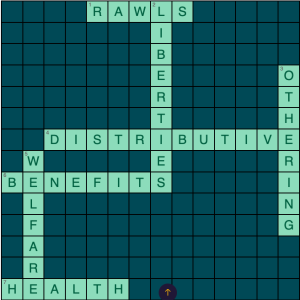
D) KINESIOLOGY AND SOCIAL JUSTICE
Exercise 5:
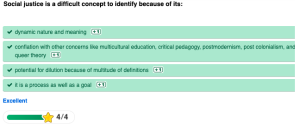
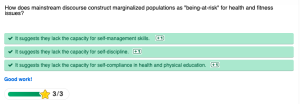
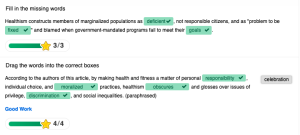
Exercise 6:
What are the implications of bodies-at-risk discourse and the refusal to understand the health gap from a social justice perspective, according to the authors of this article?
|
One implication of the bodies-at-risk discourse outlined in this article is the blame put on the individual, rather than the institutions and societal structures that put these individuals in those situations. Firstly, data gathered using statistical evidence took a more ‘post-positivist’ stance. This is a major issue as this method of interpreting data allowed for “even the particular identity, of a researcher influences what they observe and therefore impacts upon what they conclude” (Relations, 2021). This use of interpretation made theorists conclude that “marginalized groups are at-risk, and thus, irresponsible, lazy, and with cultural deficits in kinesiology, health, and disability” (Harrison, 2021). This type of thinking implies that it may create more implicit bias regarding race, as it could make people view different races as having a separate biological category. It could also make people view race or other differences as another genetic category (Harrison, 2021).Furthermore, the authors mention how this will cause the “[circulation of] racialized models of health that position ethnic-minority groups as inferior to Whites” (Harrison, 2021). The refusal to understand the health gap from a social justice point of view also allows people to “[gloss] over the diversity and heterogeneity of oppressed, marginalized, and minoritized people” (Harrison, 2021). The implications of such views outlined by the authors in this article primarily state that people view the differences between races, genders, sexual orientation, or any other difference as a ‘deficiency’, rather than just a ‘difference’ (Harrison, 2021). Implementing a more intersectionality-based approach to such issues means incorporating the voices of those who are within marginalized groups, which will tackle the refusal to understand the health gap. References Harrison, L., Azzarito, L., & Hodge, S. (2021). Social Justice in Kinesiology, Health, and Disability. Quest, 73(3), 225–244. https://doi.org/10.1080/00336297.2021.1944231 Relations, E.-I. (2021, September 26). Positivism, post-positivism and interpretivism. E. https://www.e-ir.info/2021/09/25/positivism-post-positivism-and-interpretivism/#:~:text=Postpositivists%20argue%20that%20the%20ideas,and%20knowledge%20that%20theorists%20develop.
|
Section Two: Sport Feminism
Exercise 7: Notebook Prompt
What is feminism? What does it mean to you? Choose one of the images below and explain how it captures your understanding of feminism (or find one that does speak to you and paste this into your pressbook with an explanation of why it matters to you.

| To me, feminism is the freedom for women to choose what they want. Whether that means they want to work or if they want to be a stay-at-home mom. It also means that women have the right to choose if they want to a family, or if they want to be childless. Personally, I want to be financially independent of anyone. I don’t ever want to be in a situation where I am reliant on a marriage or another person to provide safety, food, comfort, and luxury. I want to be secure enough in my job and other aspects of my life to achieve all the things I want to in my life. Feminism has enabled me to do this. I think feminism also means that we look out for each other, and we protect other women and girls. As a woman, I want to be someone who lifts other women and supports them to be the best version of themselves. The photo attached represents my idea of feminism as it shows many women and men linking arms. This is a visual representation of the support we need and appreciate as a society. I feel that we have a long way to go before true equality and support for all is achieved, however, each person’s treatment towards another is one small step to the final goal. Overall, my understanding of feminism is that we band together and support each other no matter our race, gender, sexual orientation, or any other difference we share. Through equality of opportunity and overall kindness to those around us, our society would be greatly improved.
|
Exercise 8: Notes Prompt (optional)
NB: Cornell notes is a great resource that teaches effective notetaking. Unfortunately, our system can’t save notes taken in the H5P app, so this is fully optional.
Notebook 8: Notebook
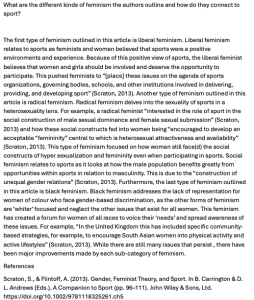
Exercise 9: Crossword Activity
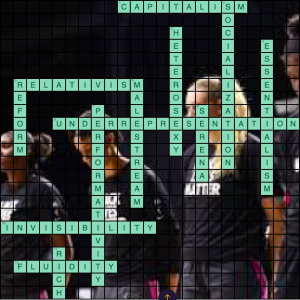
Exercise 10: Padlet Prompt
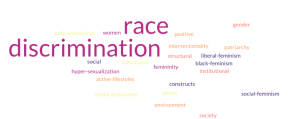
| The word cloud is a representation of the concepts covered in the article as they all tie together to tell a story. These words work together to show the problems that exist in society when it comes to the lack of and inequality of opportunities for women in sports. The words also show why feminists seek equal opportunity for women in sports, why these issues exist, and how we are fighting against such issues.
|

| It has always saddened me that women’s sports are always undervalued and even laughed at when compared to the enthusiasm and excitement that men’s sports have generated. When I would ask people “Why don’t women’s sports get much attention?” I was promptly told that it was because they were much less interesting. I could never wrap my mind around why one gender playing a sport would be much less interesting than another gender playing, after all, it was the exact same sport. I’ve since realized that misogyny and the patriarchy are to blame for the lack of investment in female-oriented sports, as I feel it’s hard for society to see women thrive when it serves no sexual gratification to the larger public. Although I feel this is still an ongoing issue, I do think the landscape is changing! Many of my female friends have become interested and invested in women’s basketball. These friends of mine never cared for men’s basketball, however, they watched one game with female teams and were hooked. I have also heard that female hockey teams have been selling out stadiums, breaking records in the female-oriented hockey realm. Thus, I do believe the landscape surrounding sports is becoming for females, and women’s sports are starting to get the appreciation they deserve. I hope to see these trends continue.
|

